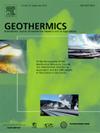增强型地热系统(EGS)开发中油气井的再利用
IF 3.5
2区 工程技术
Q3 ENERGY & FUELS
引用次数: 0
摘要
Groß Schönebeck研究平台代表了废弃烃井E GrSk 3/90的再利用案例研究。详细描述了选井标准、地下条件和井改造程序,并将其作为EGS开发的注水井重新利用的工作流程。该程序辅以一系列水力增产措施,最终形成EGS双井系统。在这项研究中,使用CMG STARS软件进行了数值模拟,通过2011年至2013年在现场进行的水力试验验证了现有矩阵主导EGS的数值模型。敏感性分析表明,基质渗透率是影响最大的参数,其次是裂缝渗透率。校正后的模型和灵敏度分析结果将作为裂缝主导的EGS概念预测模型的基础。提出了将Gt GrSk 4/05 (A2)井改造为注水井,将E GrSk 3/90井改造为地震监测井的技术可行性,以及新生产井的设计布局。该概念由16条平行水平井裂缝组成,与之前以基质为主的EGS开发概念相比,产能指数(PI)和注入指数(II)提高了16倍,产量为60 m3 h - 1。2口生产井的产量可达180 m3 h - 1,最大生产寿命为30年。本文章由计算机程序翻译,如有差异,请以英文原文为准。
Repurposing of hydrocarbon wells for Enhanced Geothermal System (EGS) development
The Groß Schönebeck research platform represents a case study for the reuse of the abandoned hydrocarbon well E GrSk 3/90. A detailed description of well selection criteria, subsurface conditions, and well modification procedures is presented as a workflow for the repurposing of hydrocarbon well as an injection well for an EGS development. The procedure is complemented by a sequence of hydraulic stimulations leading to the development of the site as an EGS doublet well system. In this study, numerical simulations were carried out using the CMG STARS software to validate the numerical model of the existing matrix-dominated EGS against the hydraulic tests carried out in the field between 2011 and 2013. A sensitivity analysis was performed and it shows that matrix permeability is the most influential parameter followed by fracture permeability. The calibrated model and the result of the sensitivity analysis were then used as the basis for a predictive model of a fracture-dominated EGS concept. The new concept is presented with the technical feasibility of repurposing Gt GrSk 4/05 (A2) well as an injection well, E GrSk 3/90 well as a seismic monitoring well, and a design layout for the new production wells. This concept, comprising 16 fractures with a parallel horizontal well configuration, exhibits a 16-fold increase in the Productivity Index (PI) and Injectivity Index (II) at a production rate of 60 m3 h−1compared to the previous matrix-dominated EGS development concept. A production rate of 180 m3 h−1is achievable with a maximum production life of 30 years with two production wells.
求助全文
通过发布文献求助,成功后即可免费获取论文全文。
去求助
来源期刊

Geothermics
工程技术-地球科学综合
CiteScore
7.70
自引率
15.40%
发文量
237
审稿时长
4.5 months
期刊介绍:
Geothermics is an international journal devoted to the research and development of geothermal energy. The International Board of Editors of Geothermics, which comprises specialists in the various aspects of geothermal resources, exploration and development, guarantees the balanced, comprehensive view of scientific and technological developments in this promising energy field.
It promulgates the state of the art and science of geothermal energy, its exploration and exploitation through a regular exchange of information from all parts of the world. The journal publishes articles dealing with the theory, exploration techniques and all aspects of the utilization of geothermal resources. Geothermics serves as the scientific house, or exchange medium, through which the growing community of geothermal specialists can provide and receive information.
 求助内容:
求助内容: 应助结果提醒方式:
应助结果提醒方式:


